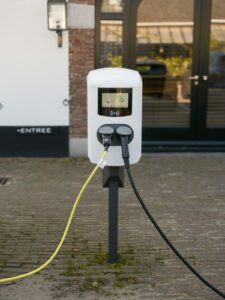
Home / EV Charging News / Commercial EV Charging Station Installation
Electric Vehicles (EVs) are a highly sustainable solution that does not release greenhouse emissions directly and have an average mileage cost of around $3.00 for every 100 miles. As the popularity of EVs increases, the need for a proper charging infrastructure rises at the same time that it becomes a business opportunity for entrepreneurs.
While EVs can be technically charged in a house, most people living in condos, residential buildings, and others, need to fulfill the electrical needs of their vehicles in public and commercial EV charging stations. In this article we will dive into this interesting business opportunity, explaining every related aspect of the commercial EV charging station installation, factors to consider, and other important details.
Commercial EV charging stations are an e-mobility solution designed for EV drivers on the road. These stations feature high-capacity equipment that can charge an EV in 2 to 10 hours for mid to high-level chargers and 20 minutes to an hour for extremely high-capacity chargers.
As there is a need for a proper EV charging infrastructure that is currently lacking in the country, commercial electric car charging points installations have and will become more popular as business opportunities. Depending on the type and number of EV charger stalls in a station, this business could deliver monthly revenues of around $4,500 to $10,125 on part-day parking charges or up to $4,050 for overnight charges.
Before performing a commercial EV charging station installation, you should define key aspects of your business. These include choosing the right commercial EV charger, defining target customers, choosing the best location, and finally performing the installation.
EV charging stations are divided into three categories or levels. This section explains each level, its power rate, and the estimated charging time:
Level 1 EV chargers are mainly used for residential applications. These chargers require a run-of-the-mill 120V outlet and have a low power consumption of around 1 kW, charging the battery of an EV in 40 to 50 hours.
Level 2 are the most popular EV chargers used for commercial applications, featuring mid to high-capacity devices requiring a 208V connection and demanding a current of up to 80 amps, delivering 19.2 kW to the EV. Level 2 commercial EV charging stations can completely charge an EV battery in 2 to 10 hours.
Level 3 EV chargers or DC Fast Chargers (DCFC) are extremely high-capacity options delivering up to 350 kW to charge vehicles in as little as 20 minutes to 1 hour. These EV charging stations represent a considerable investment and are mainly installed as public EV charging stations, delivering great benefits to EV drivers in general.
EV charging stations are a great commodity for drivers and one that they can easily adapt to their routines. This means that commercial EV charging stations can be seen in any place where EV drivers go for a coffee break, eat a meal, go shopping, or spend a day or night in general. As a result of this, commercial electric car charging points installations are better suited in the following locations:
This list only illustrates a small number of places, but the possibilities are endless. Any location where EV drivers could spend a few hours with their vehicle parked would benefit from having a commercial EV charging station installation.
The location where a commercial electric car charging point installation is performed will define many investment costs involved. Some places have properly placed service panels and well-suited electrical infrastructures for EV charging stations, while others require upgrading the infrastructure and performing expensive wiring installations due to the poor location of the service panel.
Certified electricians can easily asses you on this matter. They can either determine the viability of installing an EV charging station at a particular location or recommend other places better suited for them. In general, the best location will have easy and close access to a service panel, be in an area with a good internet connection signal and be located in a place where multiple drivers pass by.
Commercial EV charging station installations are great business opportunities with lucrative revenues, but they require proper planning. The following aspects will give your business idea a more robust design:
After considering the location and other aspects, it is time to perform the commercial electric car charging points installation. This section provides you with a simplified version of the process involved in the installation:
6. Prepare the documentation and perform the commercial electric car charging points installation. First, prepare any environmental, government permits, alongside requirements by your utility. Finally, you can have your electrician install the EV charging stalls and prepare for the safety officer to perform the inspection before opening up for business.
$2,890.00 Original price was: $2,890.00.$2,790.00Current price is: $2,790.00.
$3,950.00 Original price was: $3,950.00.$3,450.00Current price is: $3,450.00.
$1,650.00 Original price was: $1,650.00.$1,590.00Current price is: $1,590.00.
$2,290.00 Original price was: $2,290.00.$2,150.00Current price is: $2,150.00.
$1,290.00 Original price was: $1,290.00.$799.00Current price is: $799.00.

Your Power Management Partner for Over 25 Years Future Generations Depend on Our Decisions Today ™
2024 © All rights reserved by CyberSwitching